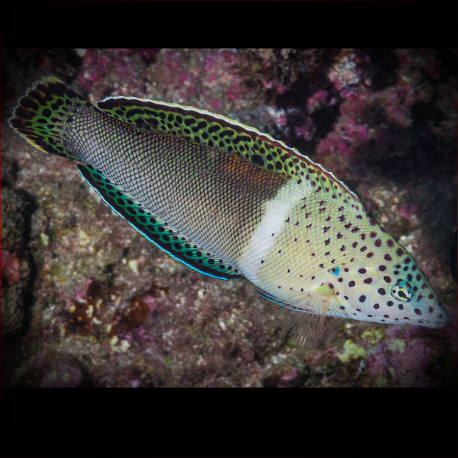More info
Datasheet
| Minimum Tank Size | 1500 litres / 396.26 US gallons |
| Maximum Size | 120.0cm / 47.24inches |
| Reef Compatible | Not reef safe |
| Temperament | Might be aggressive towards other species |
| Temperature | 22.2°C / 71.96°F - 25.6°C / 78.08°F |
| Specific Gravity | 1.020-1.025 |
| Carbonate Hardness | 8-12 |
| pH | 8.1-8.4 |
General Description
The Clown Coris, scientifically known as Coris aygula, is a member of the Labridae family. These Rainbow Wrasses undergo a dramatic transformation in appearance from their juvenile to adult stages. They have a tendency to dig into the tank substrate for sleeping or protection when threatened. Their growth potential is considerable, reaching up to 120.0cm in size, making them challenging to accommodate in a domestic aquarium when fully grown.
Aquarium Suitability
Considered suitable for aquariums with caution, Clown Coris are known to be effective hunters of invertebrates such as crustaceans, sea urchins, and worms. However, they can pose a threat to smaller fish and may nibble on clams, including Tridacna species. The species demands a large aquarium, making it difficult to house them adequately as they grow, especially as they can outgrow most home tanks.
Care and Hardiness
Noted for their hardiness, Clown Coris must be provided with a deep sandy substrate of 2-4 inches (5-10 cm) to accommodate their burrowing nature. They exhibit a tendency to rearrange rocks and sand in the aquarium, emphasizing the need for secure structures. It is essential to offer them a varied diet, including larger and small crustaceans, as well as other invertebrates.
Reef Suitability
Clown Coris are deemed not reef safe due to their hunting behavior and propensity to disturb the reef environment by foraging for food under loose objects. Their aggressive nature towards small fish and tendency to prey on bivalves and sea urchins make them unsuitable for reef setups.
Aquarium Setup
Creating an aquarium environment for Clown Coris involves providing a spacious tank with ample room for swimming. The substrate should be deep enough to allow for burrowing, and rocks should be securely placed to prevent toppling. Monitoring the fish's mouth condition upon acquisition is crucial to ensuring they have not been injured during transportation.
Behaviour
Upon introduction, Clown Coris may hide initially to acclimate themselves to the environment. Their habit of digging themselves into the substrate, coupled with their tendency to hunt for food beneath objects, underscores the need to understand and accommodate their natural behavior in the aquarium setting.
Feeding and Diet
To meet their dietary requirements, Clown Coris must be fed a diverse diet that includes larger crustaceans like shrimp and crabs, as well as small crustaceans such as krill, mysis, and artemia. A varied diet is essential to their nutrition and well-being in captivity.
Habitat and Distribution
In the wild, Clown Coris can be found in the Indo-Pacific region, ranging from the Red Sea and East Africa to the Line and Ducie islands. Their distribution extends from southern Japan to Lord Howe and Rapa islands, showcasing their presence across a vast geographic range.

